1
Understanding Learning Styles
Tanessa Sanchez and Kerry Diaz
Learning Objectives
- Understand different learning styles.
- Identify a connection between theorists and their learning theories.
Learning styles encompass the various ways individuals process information, acquire skills, and interact with their surroundings. Recognizing these differences is crucial for educators seeking to create inclusive and effective learning environments. This chapter delves into the concept of learning styles, focusing on Howard Gardner’s theory of multiple intelligences, the principles outlined in the Individuals with Disabilities Education Act (IDEA), and the importance of accommodations and modifications in education.
How do we Learn?
Learning theory refers to the various models, principles, and frameworks that aim to explain how individuals acquire, retain, and apply knowledge and skills. These theories provide insight into the ways people learn, why they learn, and the factors that affect the learning process. Over the years, educators and psychologists have developed several influential theories to understand learning better. As we go through the course we will return to different learning theories to compare and contrast different perspectives. Since how a child develops and learns is so complex and varies between individuals, it is impossible to find one theory that answers all of our questions.
Major Learning Theories
Behaviorism
Behaviorism is based on the idea that learning is a change in observable behavior. It focuses on how external stimuli (rewards, punishments, etc.) can influence a learner’s actions.
Classical Conditioning
Ivan Pavlov
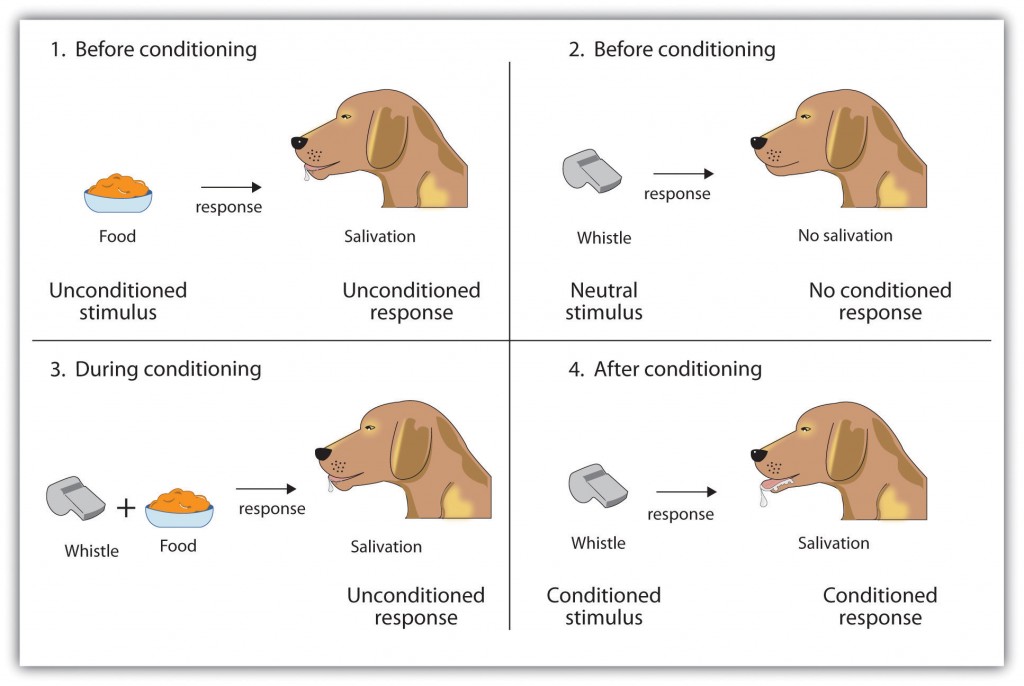
Ivan Pavlov is best known for his experiment where learning occurred through association. It demonstrated how a neutral stimulus (a sound), when paired with an unconditioned stimulus (food that naturally elicits a response), an cause the same response. For example, a dog learns to associate the sound of a bell with food, leading the dog to salivate when the bell rings.
Watch It
Watch the following video to see a re-enactment and explanation of Ivan Pavlov’s discoveries.
John B. Watson
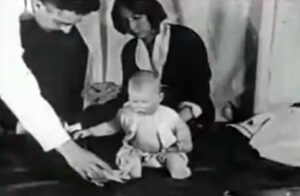
John B. Watson was a pioneering psychologist who is often considered the father of behaviorism. His work focused on the idea that psychology should be based on observable behavior rather than internal mental states, which were seen as too subjective. Watson’s most famous experiment, the Little Albert study, demonstrated that emotional responses such as fear could be conditioned in humans through associations, illustrating that behavior could be shaped by environmental stimuli. His 1913 paper “Psychology as the Behaviorist Views It” laid the foundation for the behaviorist movement, advocating for the study of behavior that could be objectively measured and analyzed, rejecting introspective methods. Watson’s work shifted the focus of psychology from the mind to the behaviors of individuals, laying the groundwork for later behaviorists like B.F. Skinner. His contribution emphasized the importance of the environment in shaping behavior, influencing educational practices, therapy, and behavioral psychology in the 20th century.
Overview of the Little Albert Experiment
The Little Albert experiment, conducted by John B. Watson and Rosalie Rayner in 1920, is a well-known study in the history of psychology that demonstrates classical conditioning, a theory of learning first described by Ivan Pavlov. In this experiment, an infant known as “Little Albert” was exposed to a white rat, which he initially showed no fear of. However, the researchers paired the appearance of the rat with a loud, frightening noise (striking a metal bar behind Albert). After several repetitions, Albert began to cry and show fear when presented with the rat—even without the noise.
This learned fear also generalized to similar stimuli: Albert showed fear toward other white, furry objects, such as a rabbit, a dog, and even a Santa Claus mask. The experiment demonstrated that emotional responses could be learned through association, supporting the behaviorist view that environment and experience shape behavior.
The Little Albert study illustrates classical conditioning, where a neutral stimulus (rat) becomes associated with an unconditioned stimulus (loud noise) to produce a conditioned response (fear). This concept is foundational in behaviorist theories of learning, which emphasize observable behaviors and how they are influenced by the environment.
Why This Matters for Educators
Understanding classical conditioning helps teachers recognize how students may develop emotional associations with learning experiences. For example, if a student is repeatedly embarrassed during math lessons, they may develop anxiety around the subject. Educators can use this knowledge to create positive, supportive learning environments that help students form healthy emotional connections with school and learning.
Note: While historically significant, the Little Albert experiment raises serious ethical concerns by today’s standards, particularly regarding informed consent and the psychological well-being of the child. It remains a cautionary example of the importance of ethical guidelines in educational and psychological research.
Operant Conditioning
Operant conditioning includes learning through reinforcement and punishment. Positive reinforcement (e.g., praise, rewards) strengthens behavior, while punishment discourages undesirable behavior.
B.F. Skinner
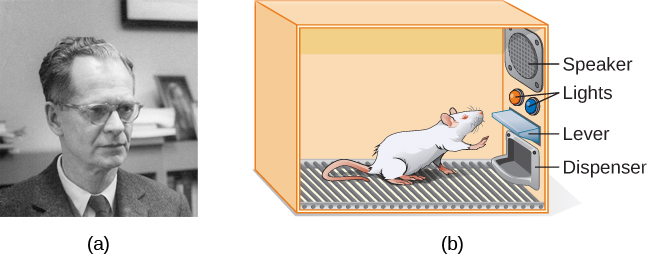
B.F. Skinner developed a framework for understanding how behaviors are influenced by consequences, focusing on four key concepts: positive reinforcement, negative reinforcement, positive punishment, and negative punishment, as well as extinction. Positive reinforcement involves adding a pleasant stimulus to increase the likelihood of a behavior being repeated, such as giving a reward for good behavior. Negative reinforcement entails removing an unpleasant stimulus to encourage a behavior, like stopping a loud noise when a desired action is performed. Positive punishment is the introduction of an aversive stimulus to decrease a behavior, such as scolding someone for breaking a rule. Negative punishment occurs when a pleasant stimulus is removed to reduce a behavior, such as taking away a privilege for misbehavior. Lastly, extinction is the gradual decrease and eventual elimination of a behavior when it is no longer reinforced. Skinner’s principles of operant conditioning emphasize how behaviors can be shaped and maintained through these various consequences. His most prolific experiment were conducted on rats and pigeons.
Application: This theory is often used in classrooms through reinforcement strategies like praise for good behavior, token systems, or providing rewards for achievements.
Cognitivism
Cognitivism focuses on the internal processes involved in learning, such as thinking, memory, problem-solving, and understanding. It sees the mind as an active participant in learning, not just a passive recipient of stimuli.
Jean Piaget
Jean Piaget was a Swiss developmental psychologist known for his groundbreaking work on the cognitive development of children. He proposed that children progress through four stages of cognitive development—sensorimotor, preoperational, concrete operational, and formal operational—each marked by distinct ways of thinking and understanding the world. Piaget’s experiments focused on how children actively construct their knowledge through interactions with their environment. One of his most famous studies involved the conservation task, where he demonstrated that young children lack the understanding that quantities remain the same despite changes in shape or appearance. This experiment, among others, illustrated that children’s cognitive abilities develop in stages and that they are not simply miniature adults but think in fundamentally different ways at different ages. Piaget’s work revolutionized the field of developmental psychology, emphasizing that cognitive development is a process of maturation and discovery rather than passive learning.
Watch It
Watch the following video to see how a 4.5 year old child navigates the conservation tasks brought forth by Piaget. Take notice of how numbers, length, liquid, mass, and area are viewed through the child’s lens.
Lev Vygotsky
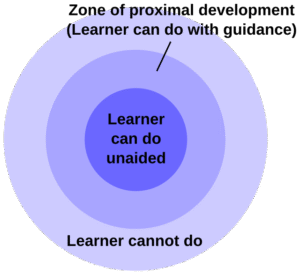
Lev Vygotsky, a Russian psychologist, is best known for his sociocultural theory of cognitive development, which emphasizes the crucial role of social interaction and cultural context in shaping a child’s learning. Vygotsky argued that cognitive development is deeply influenced by the environment and that children learn through guided interactions with more knowledgeable individuals, such as parents, teachers, and peers. One of his key concepts is the “Zone of Proximal Development” (ZPD), which refers to the difference between what a child can do independently and what they can achieve with support. Vygotsky believed that learning occurs most effectively within this zone, where instruction and collaboration help the child reach higher levels of understanding. Additionally, he emphasized the importance of language as a tool for thinking and learning, suggesting that it not only facilitates communication but also shapes cognitive processes. Vygotsky’s theory has had a lasting impact on education, advocating for collaborative learning and the importance of cultural tools in shaping intellectual development.
Jerome Bruner
Jerome Bruner was a key figure in the development of cognitive psychology, contributing significantly to our understanding of how individuals process information and learn. Bruner emphasized the importance of active learning, proposing that learners construct their own understanding through interaction with the environment, a view that contrasts with more passive learning models. In his work, he identified three modes of representation, inactive, iconic, and symbolic, through which children acquire knowledge. Bruner’s research highlighted the importance of discovery learning, where learners explore concepts and problem-solving methods on their own, promoting deeper understanding and cognitive development. His work laid the foundation for modern educational practices, emphasizing the role of language, culture, and social interaction in shaping cognitive growth.
Jerome Bruner coined the term “scaffolding” in the 1960s, based on Vygotsky’s work and studies of early language learning. Scaffolding in education refers to the instructional support provided by a teacher or more knowledgeable peer to help a learner accomplish tasks they cannot yet do independently. The term describes a dynamic process where the teacher offers guidance, encouragement, and resources at the appropriate level of difficulty, gradually reducing support as the learner gains competence and confidence. The goal of scaffolding is to bridge the gap between the learner’s current abilities and their potential capabilities, helping them achieve tasks within their “Zone of Proximal Development” (ZPD). As the learner becomes more capable, the teacher removes the scaffolding, allowing the learner to perform tasks independently. Scaffolding promotes active learning, problem-solving, and cognitive development by making learning more manageable and accessible.
Bruner believed that appropriate social interactional frameworks were necessary for learning to take place.
Watch It
Take a moment to watch the following video and gather information on how Bruner’s 3 steps of learning are applied.
Cognitivism is reflected in practices that encourage problem-solving, critical thinking, and exploration. For example, teachers might use activities like group discussions, collaborative projects, or concept mapping to support cognitive development.
Constructivism
Constructivism posits that learners actively construct their own understanding of the world through experiences and reflections. Knowledge is not transmitted but actively created by the learner based on the information they come with, where they are in their development, and what they want to walk away with.
Piaget, Vygotsky and Bruner are also considered Constructivists because of their beliefs that learners are active participants in their own learning. Additional key figures include John Dewey and Maria Montessori
Jean Piaget
Piaget’s concept of schemas refers to mental structures or frameworks that individuals use to organize and interpret information based on their previous experiences. Schemas help people make sense of the world by allowing them to categorize new information. As children encounter new experiences, they either assimilate the new information into existing schemas or accommodate their schemas to incorporate the new knowledge.
Assimilation occurs when new information is added to an existing schema without changing its structure, while accommodation involves altering the schema to fit new information. This dynamic process of adapting schemas is central to Piaget’s theory of cognitive development, as it drives the child’s ability to think and reason more complexly over time.
Watch It
Watch the following video to better understand the cognitive framework concept of accommodation and assimilation, a concept that helps organize and interpret information. Growth and development can best be seen when working with young children.
John Dewey
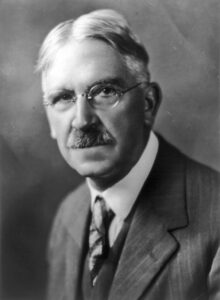
John Dewey, an American philosopher and educator, was a central figure in the development of constructivist theory, particularly through his emphasis on experiential learning. Dewey believed that learning should be rooted in real-life experiences, where students actively engage with their environment and reflect on those experiences. He argued that knowledge is constructed through problem-solving and critical thinking rather than passively received. Dewey advocated for an education system that encouraged inquiry, collaboration, and the development of practical skills, emphasizing the importance of hands-on learning and the integration of theory with practice. His idea of “learning by doing” laid the foundation for constructivist approaches in which students build their own understanding and knowledge through active participation, rather than rote memorization. Dewey’s work has profoundly influenced modern educational practices, encouraging more student-centered, dynamic, and interactive learning environments.
Maria Montessori
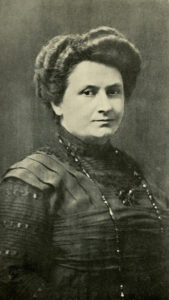
Maria Montessori, an Italian physician and educator, revolutionized education with her child-centered approach, which emphasizes the importance of fostering independence, freedom, and respect in the learning process. Montessori believed that children learn best when they are allowed to explore and discover at their own pace in an environment tailored to their developmental needs. Her educational method focuses on hands-on learning, where children engage with specially designed materials that promote sensory exploration, problem-solving, and critical thinking. Montessori also emphasized the role of the teacher as a guide, rather than a traditional instructor, allowing children to take ownership of their learning. Her approach promotes self-discipline, concentration, and a love of learning, and has been widely adopted in schools around the world, especially in early childhood education, where the focus is on nurturing the child’s natural curiosity and fostering their emotional and intellectual growth.
Teachers can encourage active learning through hands-on experiences, projects, experiments, and opportunities for students to explore topics deeply and reflect on their learning process.
Social Learning Theory
Social learning theory emphasizes the role of observation, imitation, and modeling in learning. It suggests that people can learn new behaviors and skills by observing others.
Albert Bandura

Albert Bandura, a Canadian-American psychologist, is best known for his Social Learning Theory, which emphasizes the role of observational learning, imitation, and modeling in behavior development. Bandura argued that people can learn new behaviors and acquire knowledge not only through direct experience but also by observing others in their environment, particularly those who are seen as role models. His theory introduced the concept of “self-efficacy,” the belief in one’s ability to succeed in specific situations, which plays a crucial role in motivation and achievement. Bandura’s famous “Bobo doll” experiment demonstrated that children who observed adults acting aggressively toward an inflatable doll were more likely to imitate those behaviors, highlighting the influence of observational learning. His work extended traditional learning theories by emphasizing the importance of cognitive processes, suggesting that people actively process information and make decisions based on their observations, experiences, and personal beliefs. Bandura’s contributions have had a lasting impact on fields such as psychology, education, and media studies, underscoring the importance of social context and self-belief in human development.
Watch It
Watch to learn how Albert Bandura’s Bobo Doll Experiment proved how children can learn through observations. Recognize the process that makes this experiment controversial and what Bandura was able to learn.
Humanistic Learning Theory
Humanistic learning theory focuses on the whole person and emphasizes the importance of personal growth, self-actualization, and emotional well-being in the learning process.
Abraham Maslow
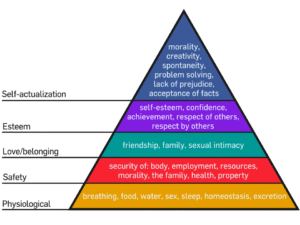
Abraham Maslow, an American psychologist, is best known for developing the Hierarchy of Needs, a theory that suggests human motivation is driven by a series of hierarchical needs. According to Maslow, individuals must first satisfy their basic physiological needs, such as food, water, and shelter, before moving on to higher-level needs. Once these basic needs are met, people seek safety and security, followed by social needs, such as love and belonging. The next level involves esteem needs, including the desire for self-respect and recognition from others. At the top of the hierarchy is self-actualization, the need to realize one’s full potential and pursue personal growth and fulfillment. Maslow believed that self-actualization is a continual process of becoming the best version of oneself, and that it can only be achieved once all lower-level needs are met. His theory has had a significant influence on psychology, education, and management, emphasizing the importance of fulfilling both basic and psychological needs for overall well-being and personal development.
Carl Rogers
Carl Rogers, an influential humanistic psychologist, developed a theory centered around the concept of self-actualization and the importance of a nurturing environment for personal growth. Rogers believed that individuals have an innate drive toward achieving their full potential, but this process is contingent upon the presence of unconditional positive regard, empathy, and genuineness in their relationships. According to Rogers, people develop a “self-concept,” which is how they perceive themselves, and this concept can either align with or diverge from their true potential or “real self.” When there is a discrepancy between the self-concept and the real self, individuals may experience incongruence, leading to anxiety and psychological distress. Rogers emphasized the need for therapy environments where clients feel accepted and understood, allowing them to explore and integrate their experiences to achieve greater self-understanding and personal growth. His work has had a profound impact on counseling, education, and interpersonal relationships, focusing on the importance of empathy, acceptance, and self-awareness in fostering well-being.
Connectivism
Connectivism is a more modern learning theory that focuses on the role of technology and social networks in the learning process. It suggests that learning is a process of creating connections between pieces of information, often through digital tools and networks.
George Siemens, Stephen Downes
George Siemens and Stephen Downes are best known for their development of Connectivism, a learning theory that emphasizes the role of networks and digital tools in the modern learning process. Unlike traditional theories that focus on individual learning, Connectivism posits that knowledge is distributed across networks of people, technologies, and resources, and learning occurs through the ability to navigate and connect these various nodes. They argue that in the digital age, the ability to access, evaluate, and create knowledge by connecting with others is just as important as internal cognitive processes. They highlight that learning is no longer confined to formal educational settings but takes place in informal, often online, environments. According to Connectivism, learners must develop skills to continuously update their knowledge, adapt to new information, and make connections across diverse fields, ensuring that learning remains dynamic and responsive to ever-changing technological and social landscapes.
Adult Learning Theory (Andragogy)
This theory focuses on how adults learn differently from children. It emphasizes that adult learners are self-directed, motivated by internal needs, and bring their life experiences into the learning process.
Malcolm Knowles
Malcolm Knowles is widely recognized for his contributions to adult education through his development of the theory of andragogy, which focuses on the unique characteristics and needs of adult learners. Knowles proposed that adults learn differently from children, emphasizing that adult learning should be self-directed, with adults taking responsibility for their own learning processes. He identified several key principles of andragogy, including the need for adults to understand why they are learning something, the importance of building on their prior experiences, the desire for practical and problem-solving learning, and the need for learning to be relevant to their life or work. According to Knowles, adults are motivated by internal factors, such as the need for personal growth or career advancement, rather than external rewards. His theory has had a profound influence on adult education, shaping programs that are more collaborative, experiential, and applicable to real-world situations.
Watch It
Andragogy is a complex term that may need further clarification. Please watch the following video where adult learning is explained using six principles.
Multiple Intelligence Theory
Howard Gardner
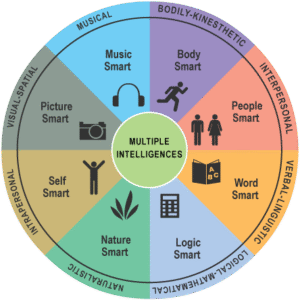
Howard Gardner’s theory of multiple intelligences, introduced in his seminal work Frames of Mind (1983), transformed the understanding of intelligence. Gardner proposed that rather than a single, general intelligence, individuals possess a range of intelligences that reflect their unique capacities and ways of learning. The eight intelligences identified by Gardner include:
- Linguistic Intelligence: The ability to use language effectively, whether in writing or speaking.
- Logical-Mathematical Intelligence: The capacity for logical reasoning, problem-solving, and mathematical thinking.
- Musical Intelligence: A sensitivity to rhythm, tone, and sound, as well as the ability to perform and compose music.
- Bodily-Kinesthetic Intelligence: The skill in using one’s body to express feelings or create products, often seen in athletes and dancers.
- Spatial Intelligence: The ability to visualize and manipulate spatial relationships, important for fields like architecture and art.
- Interpersonal Intelligence: The capacity to understand and interact effectively with others, crucial for social settings.
- Intrapersonal Intelligence: The ability to understand one’s own emotions, motivations, and goals.
- Naturalistic Intelligence: The skill in recognizing and categorizing elements in the natural world, such as flora and fauna.
Gardner’s theory encourages educators to consider these intelligences when designing their curricula. For example, students with strong musical intelligence might benefit from incorporating music into their learning, while those with interpersonal intelligence may thrive in collaborative group activities (Gardner, 1983).
Conclusion:
Learning theories provide educators with a framework for understanding how students learn, offering strategies for improving teaching practices and helping learners succeed. Each theory provides unique insights, and in practice, effective teaching often draws upon elements from multiple learning theories to address the diverse needs of students. We will cycle back to these theorists throughout the course; therefore, this is just an introduction to their ideas and theories.
Apply
Read the following anecdotes and answer:
- How does the teacher recognize each child’s intelligence?
- Why is it important for teachers to understand Multiple Intelligences?
- What intelligences do you see are most valued in school?
- How can schools begin to value all of the intelligences?
Scenario 1:
Sofia, who was often considered “different” in her school. While her classmates excelled in traditional subjects like math and language, Sofia seemed to struggle with these, often receiving low grades. Her teachers, puzzled by her performance, labeled her as “not academically gifted.”
One day, Sofia’s teacher, Mrs. Thompson, decided to assign a unique project for the class: each student would work on something that allowed them to showcase their strengths in different ways. Sofia, who had always been passionate about music and loved spending hours playing the piano at home, chose to create a musical composition that explained the process of photosynthesis. She designed a song with catchy lyrics and a simple melody, explaining how plants use sunlight to create energy.
When Sofia performed the song in front of the class, everyone was impressed by her ability to convey complex scientific concepts in such an engaging and creative way. Her classmates, who had struggled to memorize the details of photosynthesis, found themselves humming the tune and recalling the process easily.
Mrs. Thompson, realizing that Sofia’s strength lay in musical intelligence rather than traditional academic skills, gave her special recognition for her creativity. She also noticed that other students with different interests — like a classmate who loved building things — had used their own talents to make intricate models of plant cells, while another student used dance to demonstrate movement in biology.
Through this project, Mrs. Thompson understood that intelligence doesn’t come in one shape or form. Sofia wasn’t struggling with learning; she was simply expressing her intelligence in a way that was different from the conventional academic norms. It was a turning point for both the teacher and the students, as they all began to appreciate the diverse ways people can be smart — whether through music, movement, problem-solving, or social interaction.
Scenario 2
Ethan was a young boy growing up in a small rural village surrounded by forests, rivers, and fields. Unlike many of his classmates who spent most of their time indoors playing video games or watching TV, Ethan loved being outside. From a young age, he had a deep fascination with animals, plants, and the changing seasons. His parents often found him lying on his back in the grass, watching the clouds shift or carefully observing ants marching along a trail.
One afternoon, his teacher, Mrs. Harris, assigned the class a project on ecosystems. Most of the students were unsure of where to begin. They sat in the classroom, flipping through textbooks, and scribbling down notes. But Ethan, with his passion for the natural world, was already outside, exploring the edge of the nearby forest. He had a small notebook with him, where he documented the different plants and animals he encountered. He even took notes on the soil and water in the stream, noticing how the water’s clarity changed with the amount of rain that week.
When he returned to school, Ethan shared his findings with the class. He spoke enthusiastically about the different species of birds he had observed, the types of trees that grew in specific parts of the forest, and the delicate balance between the plants and animals in the area. His classmates listened, fascinated by how much he knew and how he was able to explain the connections in nature in such detail.
For his project, Ethan created a detailed map of the local ecosystem, showing the different habitats and the relationships between the various species. He even brought in a few plants he had carefully collected, explaining their role in the ecosystem, and how the plants helped support the local wildlife. His presentation was not only informative but also inspiring — it encouraged other students to spend more time in nature and think about the environment in a new way.
Mrs. Harris recognized Ethan’s remarkable naturalist intelligence — his ability to observe, classify, and understand the natural world around him. She praised his work and encouraged him to pursue his interests further. Ethan’s project wasn’t just about acing a class assignment; it was a reflection of his deep, intuitive understanding of the natural world, which he had nurtured since childhood.
Scenario 3:
Liam had always been a quiet and introspective boy, often lost in thought even when playing with his friends. While others enjoyed playing sports or games, Liam spent most of his time solving puzzles or experimenting with numbers. Even at a young age, he was fascinated by patterns, sequences, and the ways things fit together logically.
One day, Mrs. Thompson, his math teacher, gave the class a challenging problem: “If you have 100 coins, and each time you flip a coin, it lands heads up or tails down, how many flips does it take to guarantee that you have an equal number of heads and tails?” The students scratched their heads, unsure of how to approach it. Many of them quickly gave up or tried random guesses, but Liam was determined to figure it out.
Instead of just trying to flip the coins randomly, Liam began thinking logically about the problem. He quickly recognized that it wasn’t about the outcome of each flip, but rather the total number of flips. “I know that for every coin, I have two possible outcomes: heads or tails,” Liam thought. “If I want an equal number of heads and tails, I need to be sure the number of flips will allow for this balance, no matter the order.”
Liam went home that evening and set up a system to test different scenarios. Using a pen and paper, he mapped out sequences of flips, analyzing how the number of heads and tails changed with each flip. After several hours of calculations and diagrams, he discovered that to guarantee an equal number of heads and tails, you would need at least 99 flips — because with every flip, the number of heads and tails could be out of balance, but after 99 flips, the 100th flip would always create a situation where heads and tails are equal, no matter the results of the other flips.
The next day, Liam proudly shared his solution with the class, explaining not only the answer but the logical steps he took to arrive at it. His classmates were amazed by his thought process and how he used abstract thinking and mathematical reasoning to solve the problem. Mrs. Thompson praised Liam for his ability to break down a complex problem and think critically about the solution, recognizing his exceptional mathematical intelligence.
References
- Cason Smith. (2014). The Six Adult Learning Principles. [Video]. YouTube. https://youtu.be/vLJ7cRwKI-I?si=WZsv-Qcx1FUZNfTO
- Flactemb. (2013). Pavlovs Dogs. [Video]. YouTube. https://youtu.be/asmXyJaXBC8?si=VlgVCY9BU8p7wqcD
- Munakatay. (2011). A typical child on Piaget’s conservation tasks. [Video]. YouTube. https://youtu.be/gnArvcWaH6I?si=LDVONNSFuTzDRfoy
- Sprouts. (2020). Bruner’s 3 Steps of Learning in a Spiral Curriculum. [Video]. YouTube. https://youtu.be/rZfAsbhfL_Y?si=Ed6coMQbWKRRf0EC
- Sprouts. (2021). Piaget’s Schema: Accommodation and Assimilation of New Information. [Video]. YouTube. https://youtu.be/EYbCE1udazw?si=ZvZ3mHlbB7teOyor
- Sprouts. (2022). Social Learning Theory. Bandura’s Bobo Beatdown Experiments. [Video]. YouTube. https://youtu.be/XHIhkM1cAv4?si=MGFFK1veRkTFeIbU
Media Attributions
- Ivan Pavlov is licensed under a Public Domain license
- Little Albert © David Web is licensed under a CC BY (Attribution) license
- Skinner Box adapted by OpenStax College is licensed under a CC BY (Attribution) license
- Zone_of_proximal_development.svg © Dcoetzee is licensed under a CC0 (Creative Commons Zero) license
- John_Dewey © Library of Congress adapted by Wikimedia Commons is licensed under a CC BY (Attribution) license
- Dr._Maria_Montessori © Unknown is licensed under a CC0 (Creative Commons Zero) license
- Bobo_Doll_Deneyi © Okhanm is licensed under a CC BY-SA (Attribution ShareAlike) license
- Maslow’s_Hierarchy_of_Needs.svg © Factoryjoe is licensed under a CC BY-SA (Attribution ShareAlike) license
- Multiple_intelligences_of_Howard_Gardner © Howard is licensed under a CC BY-SA (Attribution ShareAlike) license

